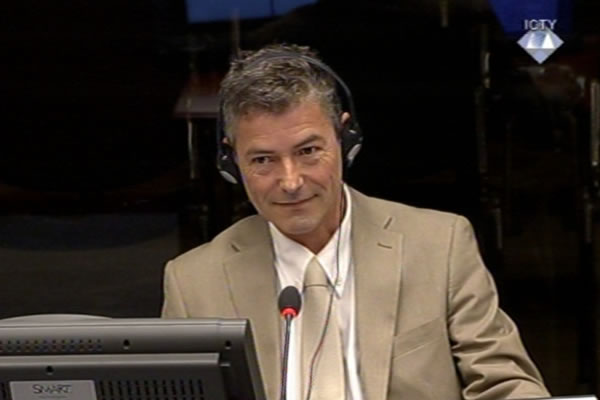Home
FIVE STAGES OF SREBRENICA INVESTIGATION
In his sixth and probably last testimony at the Tribunal, the former head of the Srebrenica investigation team once again set the stage for the prosecution’s evidence about the crimes committed after the fall of Srebrenica in July 1995. Ratko Mladic was the commander of the VRS Main Staff at the time: now he is on trial for those crimes
 Jean-Rene Ruez, witness at the Ratko Mladic trial
Jean-Rene Ruez, witness at the Ratko Mladic trial From July 1995 to July 2001, French police inspector Jean-Rene Ruez headed the OTP’s Srebrenica investigation team. On 20 July 1995, Ruez was already in Tuzla. Since January 1996, when the international forces were deployed in the area, Ruez has searched the Srebrenica killing fields countless times. As he did at all previous Srebrenica trials, in his evidence at Ratko Mladic’s trial, Ruez once again described how the investigation to determine the fate of about 8,000 Bosniak men was conducted. The Bosniak men went missing after the VRS overran the Srebrenica enclave on 11 July 1995.
The purpose of Ruez’s testimony at the beginning of the Srebrenica stage of the prosecution’s case is to help the judges and the public following the trial to find their bearing in an area of about 2,800 square kilometers: the scene of what might very well be the largest-scale crime investigation of the 20th century.
The Srebrenica investigation began on 20 July 1995 when statements were taken from the refugees who had been transferred from Potocari to Tuzla, and from the people who had been in the column of soldiers and civilians and who managed to break through to the territory under the BH Army control. In early 1996, after the Dayton agreement and the deployment of IFOR, the OTP investigators launched their first field missions to the Srebrenica territory. On the trail of the witness statements, the investigators tried to find the locations where the events unfolded. In the third stage, they looked for the primary and secondary mass graves and the exhumations began. The next stage was the identification of units and individuals involved in the Srebrenica crimes. The headquarters of the Drina Corps, and the Zvornik and Bratunac Brigade were searched. Numerous military documents were seized. Transcripts and recordings of intercepted conversation between the VRS personnel involved in the Srebrenica operation were analyzed. Finally, before the indictments were issued, the suspects from the Bosnian Serb army and police were interviewed.
For Ratko Mladic’s trial, the prosecution put together a folder containing about 250 maps, photos and aerial pictures of the wider Srebrenica area where the crimes the former VRS Main Staff commander is charged with were committed. All the key locations for the reconstruction of the Srebrenica events are marked on the maps. They include the direction in which the people of Srebrenica moved after Mladic’s forces overran the enclave on 11 July 1995, the locations where Bosniak men surrendered or were captured and the places - schools, hangars and cultural centers - where they were provisionally detained. The maps also show the execution sites where Bosniaks were summarily executed. The locations are illustrated with a series of aerial photos taken in July 1995. Some of them were handed over to the Tribunal by the US government and others were taken by the OTP investigators from helicopters or on the ground. According to Ruez, the video recordings of Belgrade ‘journalist-cum-propaganda man’ Zoran Petrovic Pirocanac were of particular importance. Pirocanac recorded the footage in the area on 13 and 14 July 1995.
The testimony of the former leader of the Tribunal’s Srebrenica investigation team will continue tomorrow.
Linked Reports
- Case : Mladic
- 2013-04-10 MLADIC REMOVED FROM COURT
- 2013-04-09 MLADIC TRIAL ADJOURNED
- 2013-04-08 NEW BREAK AT MLADIC’S TRIAL
- 2013-04-12 SREBRENICA INVESTIGATION, MADLEINE ALBRIGHT AND MLADIC’S DIARIES
- 2013-04-17 DEFENSE OBJECTS TO 'SREBRENICA MAP COLLECTION'
- 2013-04-18 MLADIC’S ‘THREATENING’ RHETORIC
